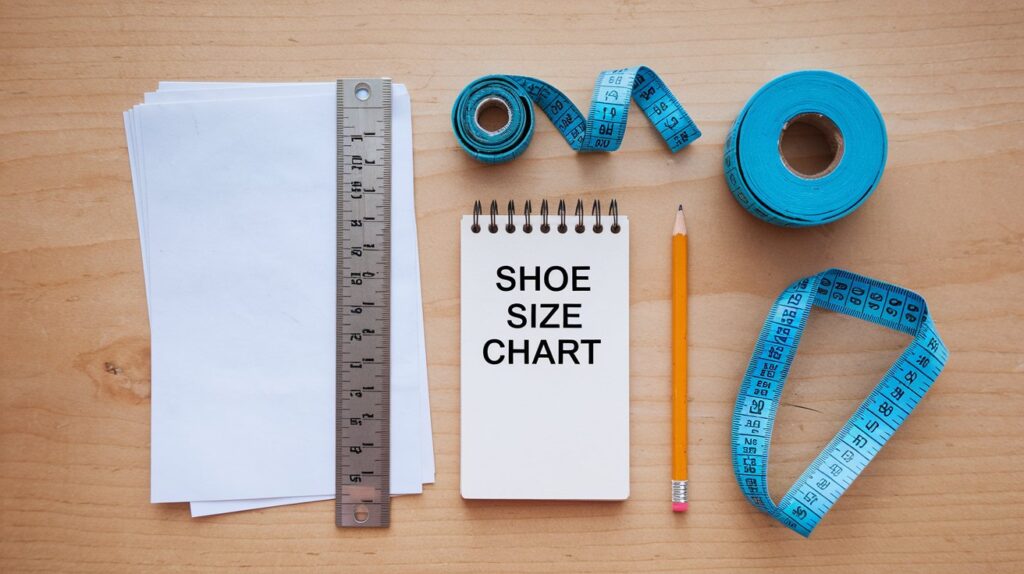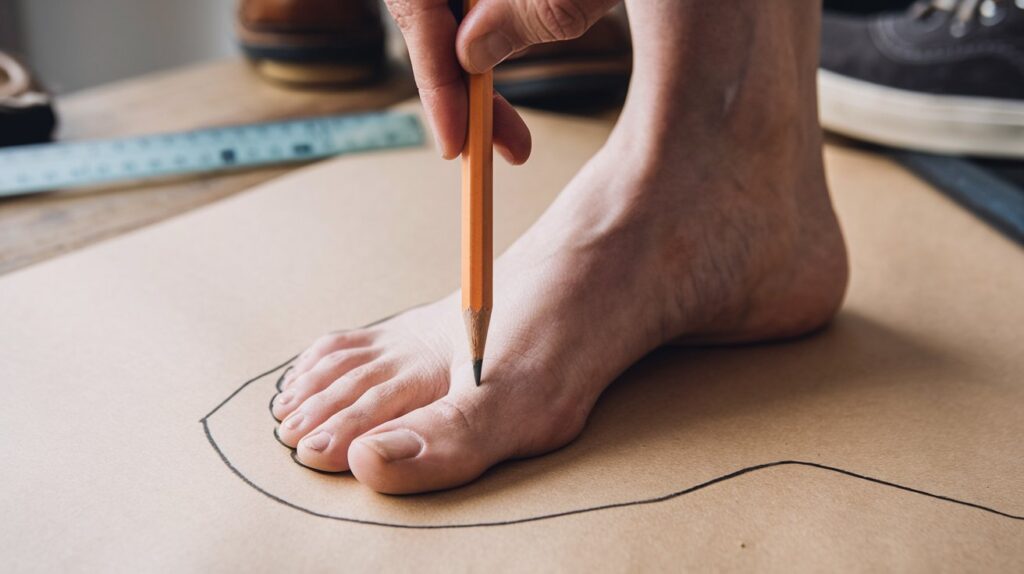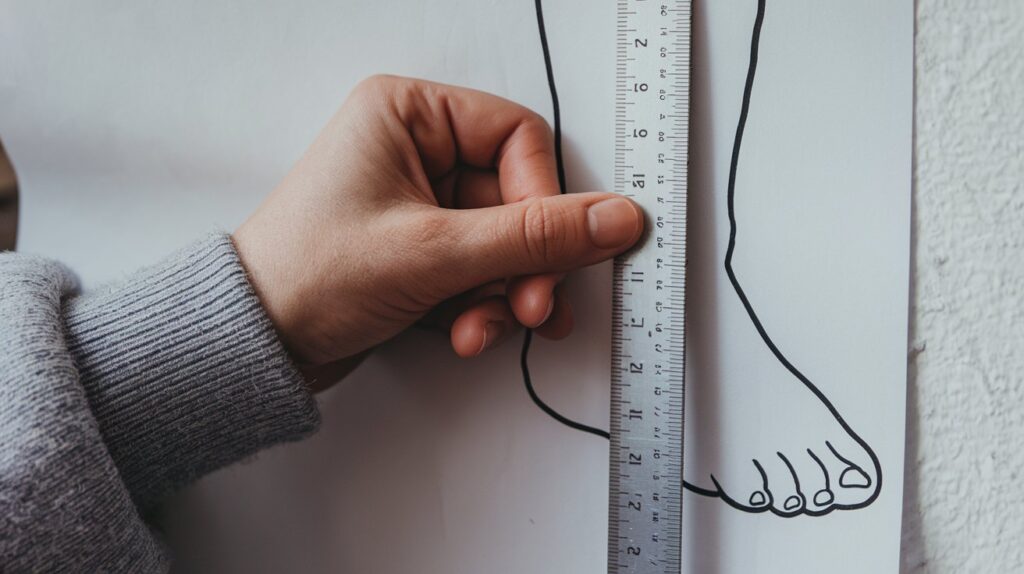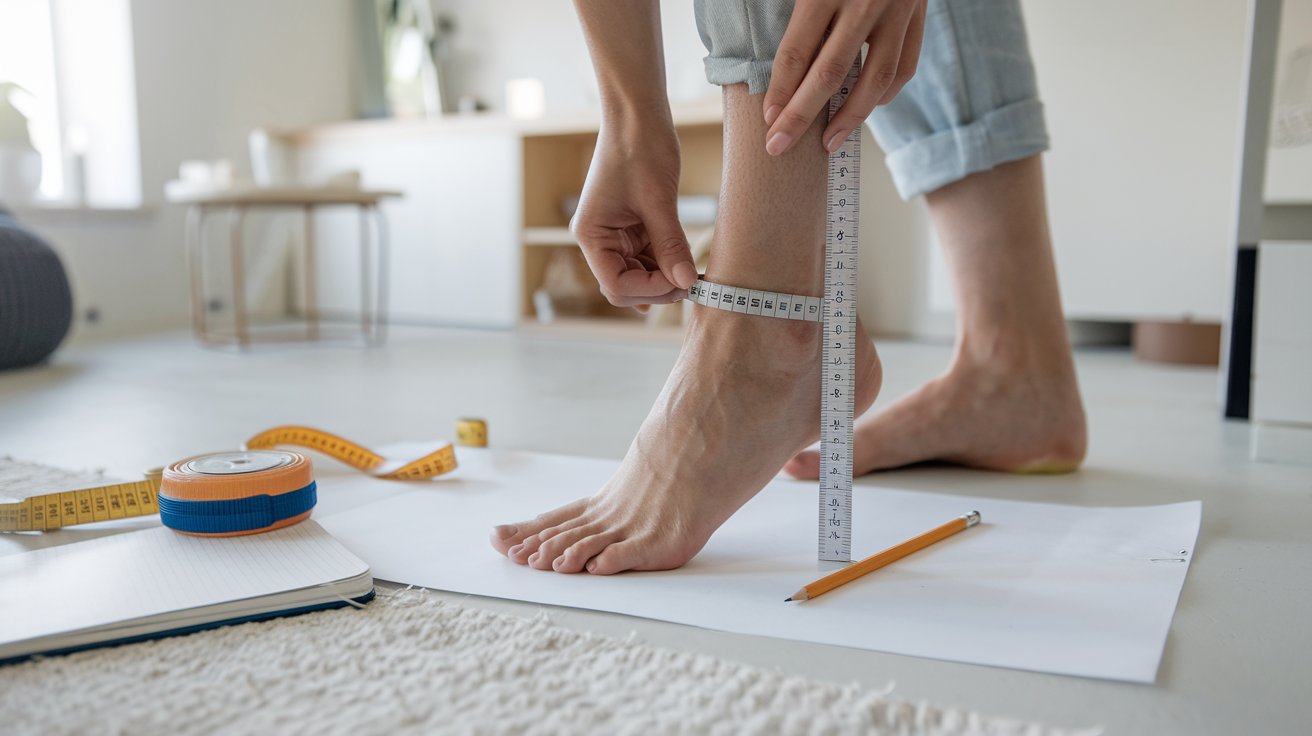Finding the right shoe size is vital for comfort. Ill-fitting shoes can cause pain and health issues.
Measuring your feet correctly ensures you get the right fit every time. Many people guess their shoe size, leading to discomfort and wasted money. By taking a few simple steps, you can measure your feet accurately at home. This guide will show you how to measure your feet, so you can choose the perfect shoes.
Accurate measurement helps in buying shoes online and ensures all-day comfort. Let’s make shoe shopping a pleasant experience by getting the size right from the start. Read on to learn how easy it is to measure your feet for the perfect shoe fit.
Importance Of Measuring Feet
Measuring your feet is crucial before buying new shoes. It ensures you get the right size. Properly fitting shoes can make a huge difference. This simple step can prevent many problems. It also helps improve comfort and foot health.
Proper Fit
Getting the correct shoe size means a proper fit. Shoes that fit well can support your feet better. This support can prevent injuries and improve stability. A good fit also enhances your overall comfort. No more pinching or rubbing!
Avoiding Discomfort
Wearing the wrong shoe size can cause discomfort. Too tight shoes can pinch and squeeze your feet. Too loose shoes can cause blisters and slips. Both can lead to foot pain and other issues. Measuring your feet can avoid these problems.
Tools Needed

Ensuring you wear the correct shoe size is essential for comfort and health. To measure your feet accurately, you need specific tools. These tools will help you get precise measurements, ensuring you choose the right shoe size. Let’s look at the tools needed for this process.
Measuring Tape
A measuring tape is a flexible tool that helps you measure the length and width of your feet. It is easy to use and provides accurate measurements. Follow these steps:
- Sit down and place your foot flat on a sheet of paper.
- Wrap the measuring tape around the widest part of your foot.
- Note down the measurement in inches or centimeters.
Paper And Pen
You need paper and a pen to trace your foot. This will help you get an accurate outline of your foot. Here’s how to do it:
- Place a sheet of paper on the floor.
- Stand on the paper with your full weight.
- Use the pen to trace around your foot.
Ruler
A ruler is necessary to measure the length and width of your foot tracing. This will give you accurate dimensions. Follow these steps:
- Use the ruler to measure the length from the heel to the longest toe.
- Measure the width at the widest part of your foot.
- Write down both measurements.
Having these tools makes it easy to measure your feet accurately. This ensures you select the correct shoe size, providing comfort and support for your feet.
Preparing For Measurement
Accurate foot measurement starts with proper preparation. Ensuring you follow the right steps can lead to a better fit. This section will guide you through choosing the right time and wearing appropriate socks for the best results.
Choosing The Right Time
The best time to measure your feet is in the evening. Feet tend to swell throughout the day. Measuring later ensures a more accurate size. This helps prevent shoes from feeling tight later on.
Wearing Appropriate Socks
Wear the socks you plan to use with the shoes. This includes athletic socks for sports shoes or dress socks for formal shoes. The thickness of the socks can affect the measurement. It ensures the shoes fit comfortably with the socks you’ll wear.
Step-by-step Guide
Finding the right shoe size is crucial for comfort. Here’s a simple step-by-step guide to measure your feet accurately. Follow these steps to ensure you get the perfect fit.

Tracing Foot Outline
Start by placing a blank piece of paper on the floor. Make sure the paper is larger than your foot.
- Stand on the paper with your full weight.
- Trace the outline of your foot with a pencil. Keep the pencil upright and close to your foot.
Repeat this process for the other foot. Most people have one foot slightly larger than the other.
Measuring Length
Once you have your foot outlines, it’s time to measure the length.
- Use a ruler or measuring tape.
- Measure from the longest toe to the heel’s edge.
Note this measurement in both inches and centimeters. Shoe sizes vary between brands, so having both units is helpful.
Measuring Width
Next, measure the width of your foot.
- Take the widest part of your foot outline.
- Use a ruler or measuring tape to get the width.
Record this measurement as well. Width is just as important as length for a good fit.
Here’s a summary table for clarity:
| Foot | Length (inches) | Length (cm) | Width (inches) | Width (cm) |
| Left Foot | ___ | ___ | ___ | ___ |
| Right Foot | ___ | ___ | ___ | ___ |
Always use the larger foot’s measurements for buying shoes. This ensures you get a comfortable fit.
Tips For Accurate Measurements
Accurate foot measurements are crucial for finding the right shoe size. Incorrect measurements can lead to discomfort and foot problems. Follow these tips to ensure you get the best fit for your shoes.
Ensuring Flat Surface
Place a piece of paper on a flat, hard surface. Avoid carpets or uneven floors. Stand on the paper with your full weight evenly distributed. This ensures your foot flattens out naturally.
Double Checking Measurements
Measure both feet, as one foot can be larger than the other. Use a ruler or measuring tape to measure from the heel to the longest toe. Note the measurements in inches or centimeters. Repeat the process to confirm accuracy. Record the larger measurement if there is a difference.
Converting Sizes
If you’re buying shoes from international brands, you may need to convert your size. Use online conversion charts and remember that sizes may not always align perfectly across regions. When in doubt, choose a half-size larger for comfort.
Here is a sample shoe size conversion chart for reference:
| US Size | UK Size | EU Size | Foot Length (cm) |
|---|---|---|---|
| 6 | 5 | 39 | 23.5 |
| 7 | 6 | 40 | 24.4 |
| 8 | 7 | 41 | 25.4 |
| 9 | 8 | 42 | 26 |
| 10 | 9 | 43 | 27 |
Understanding Shoe Size Charts
Understanding shoe size charts is crucial for finding the perfect fit. Different brands and regions use varied sizing standards. This can make finding the right shoe size challenging. Let’s explore how to navigate these charts effectively.

Different Standards
Shoe sizes vary across the world. The US, UK, and Europe use different systems. The US system includes both men’s and women’s sizes. The UK system is similar but slightly different. European sizes use a single system for all adults.
Some brands also have their own sizing charts. Always check the specific brand’s chart before buying shoes. This ensures a better fit and comfort.
Converting Measurements
Converting shoe sizes between different systems is important. Measure your feet in inches or centimeters. Use a conversion chart to find your size in another system. Many online tools can help with this process.
Be aware that conversions are not always exact. Try shoes on when possible. Each brand and style may fit differently. Understanding conversions helps in making better choices.
Special Considerations
When measuring feet for shoe size, some special considerations can make the process easier. These factors can influence the accuracy of the measurement and ensure a better fit.
Children’s Feet
Children’s feet grow quickly. Measure their feet every few months. This helps in getting the right size. Use a ruler or a measuring tape. Let your child stand on a piece of paper. Mark the heel and the longest toe. Measure the distance between these points. Compare the measurement with a shoe size chart.
Children’s feet are often wider. Choose shoes that allow room for growth. Ensure there is enough space in the toe box. The heel should fit snugly. Look for shoes with adjustable straps or laces.
Wide Or Narrow Feet
Wide or narrow feet need special attention. Measuring the width is crucial. Stand on a piece of paper. Trace the outline of the foot. Measure the widest part of the foot. Compare the width with a shoe width chart.
For wide feet, choose shoes labeled “wide” or “extra wide.” Look for shoes with a roomy toe box. Avoid shoes with a narrow fit. For narrow feet, look for “narrow” labeled shoes. Ensure the shoes fit snugly to avoid slipping.
Always try on shoes at the end of the day. Feet tend to swell by evening. This ensures a more accurate fit. Walk around in the shoes. Check for any discomfort or tightness. Comfort is key for both wide and narrow feet.
Trying Shoes On
Measure feet for shoe size by tracing each foot on paper. Use a ruler to measure the longest and widest parts. Compare measurements to a shoe size chart for best fit.
Trying shoes on is a crucial step in finding the right fit. Properly fitted shoes ensure comfort and prevent foot problems. Follow these steps to make sure your shoes fit perfectly.
Walking Test
Walk around in the shoes. Pay attention to how they feel. Do your heels slip out? Are your toes cramped? Make sure there is about a half-inch of space from your longest toe to the front of the shoe. This helps prevent blisters and discomfort. The shoes should bend where your foot bends. This ensures natural movement and comfort.
Checking For Pressure Points
Stand up and feel for any tight spots. Do you feel any pinching or rubbing? These are pressure points. Shoes should fit snugly but not tightly. Press your thumb on the top of the shoe. Your toes should have some wiggle room. This prevents nail damage and promotes healthy feet. Take off the shoes and check your feet. Any red marks mean the shoes are too tight. They might cause pain over time.
“`
When To Re-measure
Knowing when to re-measure your feet for shoe size is crucial. Feet can change over time. This ensures you always have a perfect fit.
Signs Of Improper Fit
Do your shoes feel tight or cause blisters? These are signs of an improper fit. Here are some common indicators:
- Pain in your feet or toes
- Red marks on your skin after wearing shoes
- Frequent slipping or sliding of your feet in the shoes
- Calluses or bunions developing over time
If you experience any of these signs, it’s time to re-measure your feet.
Changes In Foot Size
Feet can change size for many reasons. Your feet may have grown or shrunk. Here are some common factors:
- Weight gain or loss
- Pregnancy
- Aging
- Health conditions such as diabetes
Such changes can affect your foot size. Re-measuring ensures your shoes always fit well.
Frequently Asked Questions
How Do I Measure My Feet At Home?
Use a ruler, paper, and pen. Trace your foot, then measure the length and width.
What Time Of Day Should I Measure My Feet?
Measure your feet in the evening. Feet swell throughout the day and are largest then.
Why Is It Important To Measure Both Feet?
One foot is often larger. Measure both to find the best shoe size for each foot.
Conclusion
Measuring your feet correctly is key to finding the perfect shoe size. Accurate measurements ensure comfort and avoid foot pain. Follow the steps outlined and you’ll find the best fit every time. Remember to measure both feet as sizes can differ.
Use a ruler or tape measure for precision. Shoes that fit well make walking and running more enjoyable. Happy shoe shopping!



Leave a Reply